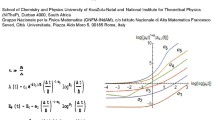Abstract
Modifications of the analyticity properties of Feynman diagrams (in particular, the so-called “substitution law”) due to the presence in the internal lines of propagators of unstable particles, are investigated.
The discussion is restricted to the one and two particle structures i.e. those characterized by poles or branchpoints induced by one or two internal lines respectively when one of the latter is a propagator of an unstable particle.
The existence of unstable particles is indicated to be consistent with a canonical model; a detailed discussion is not included here1. The model is perturbationtheoretic; non-observables being treated in a familiar way only after suitable modifications to the Dyson prescriptions have been made.
Before the relation between the singularities (poles, branchpoints) induced by internal lines corresponding to unstable particles and the masses associated with such internal lines can be appreciated, the analogous relation in terms of stable particles must be made completely explicit. This task is accomplished in the third chapter. Chapter 4 then deals with the one-particle structure realized when the internal line is due to an unstable particle. In this case the scattering amplitude has, in terms of the energy-variable for that line, a cut from (2m)2 to ∞ where 2m is the sum of the masses of the stable decay products — it also has an analytic continuation through this cut with a pole atM 2−i γ in the second sheet, whereM denotes the observed mass of the unstable particle and γ is proportional to the inverse life-time of the unstable particle — see chapter 4.
Chapter 5 deals with the two-particle structure realized when one internal line is due to an unstable particle of massM and the other to a stable particle of massm a,r =m — see below. The unstable particle can decay into two stable particles each of massm a,r =m. The arguments of this section indicate that the scattering amplitude has a cut, in terms of the energy-variable for that channel [−P 1 +P 2)2 in the case of Fig. 9] from (3m)2 to ∞ as well as an analytic continuation through the cut into the lower half plane. In the second Riemann sheet there exist branch-points at\((\sqrt {M^2 \pm i\gamma \pm m} )^2 \) and at infinity.
Zusammenfassung
Wenn eine Zerlegung der Feynman-Diagramme eines Streuvorgangs (s. Abschnitt 3 oben) in zwei Teile möglich ist, derart, daß zwischen den beiden Teilen eine einzelne (instabile) Linie verläuft, so hat die Streuamplitude, als Funktion der Energievariable dieser Linie [−(p 1 +p 2)2 in der Fig. 5 bzw. −(P 2 −P 3)2 in der Fig.6] eine analytische Fortsetzung in ein zweites Blatt mit einem Pol an der Stelle, wo die [„komplexe“ Masse]2 des instabilen Teilchens liegt.
Similar content being viewed by others
Author information
Authors and Affiliations
Additional information
Der Verfasser erlaubt sich an dieser Stelle Herrn Dr. K.Symanzik, Herrn Prof. Dr. S.Mandelstam und Herrn Prof. Dr. H.Rund für wertvolle Hinweise sowie auch Herrn Dr. A. P.Burger für seine freundliche Anregung zur Abfassung dieses Beitrags zu danken
Rights and permissions
About this article
Cite this article
Henning, J.J. Instabile Teilchen in der Störungstheorie. Z. Physik 177, 227–239 (1964). https://doi.org/10.1007/BF01375496
Received:
Issue Date:
DOI: https://doi.org/10.1007/BF01375496



